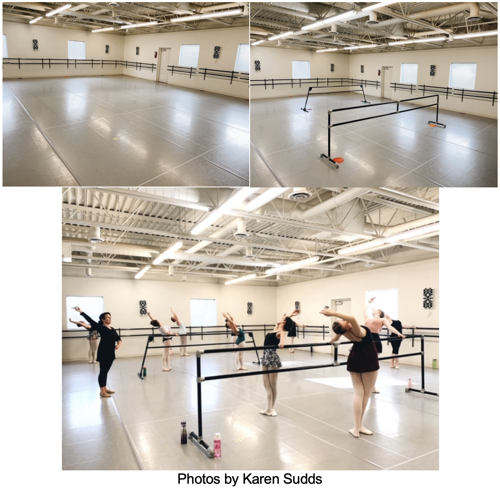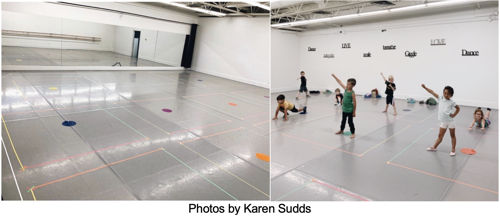Reopening dance studios in a global pandemic
Authors: Karen Sudds and Charmaine Tay on behalf of the Dance Educators' Committee
As dance studios begin to re-open, IADMS members from across the world talk about their experiences of reopening studios amongst a global pandemic, the measures they have put in place, the challenges they have faced, and the dancers’ reactions to returning.
Karen Sudds MSc Dance Science, Owner/Director Crossings Dance, Co-Vice President Healthy Dancer Canada
For over 30 years I have owned and directed a dance school in Calgary, Alberta, Canada. We are a non-competitive program focused on preparing dancers (ages 3 to adult) to enter pre-professional and professional training. The core components of training are ballet, modern, contemporary, and conditioning. Like studios around the world, within the space of two weeks, we transitioned to a virtual studio. Few of us were prepared for the rapid changes, technological demands, and adaptability required to shift our teaching and business models. However, as artists and innovators, the dance community has risen to the challenge of creative and collaborative solutions.
Looking back 5 months, I realize that the years invested in building a strong foundation of values and a team approach to leadership, helped us navigate the constantly shifting ground. We focused on timely, consistent, and clear (calm) communication which helped us keep our students and parents engaged and committed to their dance training. Our number one goal throughout was to keep things as normal as possible for the children by providing structure, stability, and community.
Dance teaching being unregulated in Canada created additional challenges for studios and government alike when planning the return to the studio. Fortunately, the Alberta Dance Educators Association put out a call to dance studios to collaborate on the development of a protocol for staged reentry. Over 100 dance studio owners worked together and signed the proposal which is now being implemented in the re-opening of studios across the province.
The basic measures we have taken to ensure our students’ and staffs’ safety include:
- Daily “Fit For Dance” health screening questionnaire for anyone entering our facility
- Temperature checks and hand sanitization upon arrival
- Masks are mandatory in our city when in any public space for ages 11+. This includes wearing a mask during drop off and pick up, while in the foyer, transitioning between classes, and during breaks between classes. Students and teachers are not required to use a mask when dancing. However, teachers are required to mask up before approaching students for corrections.
- Studios have been sectioned into grids (“Dance Pods”). The size of the grids varies depending on the size of the studio and are between 6.5ftx6.5ft with a 3ft separation and 7ftx9ft. The teaching area is 10x10 and there is a 3ft perimeter for barres along with space to accommodate equipment for virtual teaching.
- Class sizes are determined by the number of Dance Pods available in each room and the total capacity of the facility.
- Breaks have been allocated between classes for cleaning using a non-toxic government recommended fogging machine along with sanitizing all touchable surfaces.
The adjustments have been largely well-received however, face coverings are still a highly debated and polarizing issue in our city. To overcome this, we have made it part of our “Fit For Dance” campaign which will also include components such as nutrition, rest, sleep, hydration, warm-up, and cool down. If for medical reasons, a student or teacher cannot wear a mask, they must provide a medical note. Our goal is to normalize these new protocols and make them a natural part of safe dance training.
The Dance Pods have been a hit with younger students (3-8yrs) during the summer camps. Teachers have commented that it is much easier to keep the children safely spaced when they have a clearly outlined space. We chose to use brightly colored stage tape with each line of the square being a different color. The children were excited about the colors and the teachers were able to use the lines and colors in creative ways, for example, having the children tiptoe on the pink line, hop on the green line, chase sideways on the yellow line, crawl on the orange line, leap from the pink line to the green line, roll from the yellow to the orange, balance on the green line, turn from the green and orange corner to the pink and yellow corner. By doing this, the children remain a safe distance apart yet can move more freely. The goal was to make the Pods feel special and not restrictive.
Our older students have struggled more with the grid system. After dancing in small spaces at home, being restricted in the studio has been a bit of a hurdle. This is particularly true for contemporary floor work and traveling movement. We have addressed this by having the students sanitize their hands before and after floor work so they can move outside their dance pod. When traveling across the floor, one person goes at a time while the others stand on dots placed along the sides of the room (2-meter distance). Both physically and emotionally, this has given the dancers and teachers an increased sense of freedom.
We are moving into our fourth week of in-studio dance camps and the fourth week of summer dance classes. A virtual option is being provided for students who are not comfortable coming into the studio. For September we are planning a full in-studio schedule with a virtual option with staggered start times to allow for sanitization. It will require an innovative and collaborative approach to dance education.
I am grateful to organizations like IADMS for providing research, education, and practical support for dancers and dance educators during this pivotal time in our history.


*****
In this short vlog Charmaine Tay walks us through the current COVID procedures in place at City Ballet Academy, Singapore.
Charmaine Tay is currently lecturing dance science and anatomy at the dance department of Lasalle College of the Arts (Singapore) and also teaches body conditioning, advanced ballet, and advanced jazz with the musical theatre department. Charmaine also coaches the competition team and Elite students at the City Ballet Academy in Singapore for local and international dance competitions. She has recently started a local dance science project, *Scapedance science, aiming to educate dancers and dance educators in the Asian region.